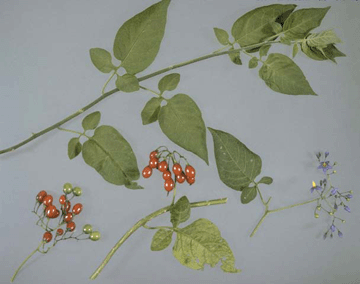Ralstonia solanacearum Race 3 Biovar 2
Descalgar la guía descriptiva al formato PDF |
Roll your mouse over the red-colored words to see word definitions. This will open Pop-up windows. If not, print the glossary
 |
| |
| |
Printer friendly  |
PDF file  |
Glossary  |
| Disease cycle and epidemiology |
 |
R. solanacearum race 3 biovar 2 is a soilborne and waterborne pathogen; the bacterium can survive and disperse for various periods of time in infested soil or water, forming a reservoir for source of inoculum for the pathogen. It is not airborne although there is some evidence of survival of the bacterium on the outside of the plant (epiphyte) under conditions of high relative humidity.
The bacterium can survive for days to years in water, wet soils or deep soil layers (>
29.5 in), depending on temperature conditions. In aquatic habitats, factors such as pH, salt level, surfaces provided by particulate matter, and the presence of competing, antagonistic or parasitic organisms can affect bacterial survival. Soil moisture content, soil type and plant material content in soil also can play a critical role in its survival in this habitat. At low temperatures (<
39.2ºF), bacterial population densities fall rapidely but the bacteria still can survive, often in a physiological latent state.
In natural habitats, R. solanacerum race 3 biovar 2 can survive during the winter in semi-aquatic weeds, in plant debris or in the rhizophere of non-host plants that act as reservoirs for the pathogen and release bacteria when temperatures start to increase after winter.
R. solanacearum primarily infects host plants through the roots. It penetrates the host through wounds at the points of emergence of lateral roots or through root damage that may be caused by soil-borne microorganisms, such as the root-knot nematode, or by handling. The synergistic interaction between the root-knot nematode and R. solanacearum on a variety of hosts is widely recognized. It can also penetrate into plants by way of stem injuries from insects, handling or tools. Once infection has occurred in the roots, bacteria will colonize the plant through the xylem in the vascular bundles, a process which is accelerated by higher temperatures. R. solanacearum race 3 biovar 2 is most severe on plants between
75-95ºF (optimal temperature of
80.5ºF) and decreases in virulence when temperatures exceed
95ºF or fall below
53.6ºF.
Because of
vegetative propagation, infected potato seed tubers and infected geranium cuttings can play a major role in dissemination of the bacterium, particularly during latent infections. The pathogen is not known to be disseminated through tomato seeds. Plant-to-plant contamination can occur when bacteria move from roots of infected plants or weeds to roots of nearby healthy plants. The pathogen can be spread from infested to healthy fields by soil transfer on machinery and surface runoff water after irrigation or rainfall. It also can be disseminated from infected ponds or rivers to healthy fields through waterways. In Europe, the semi-aquatic weed Solanum dulcamara (bittersweet or climbing nightshade) (Photo 15) infected with R. solanacearum race 3 biovar 2 was shown to play a major role in propagation of the pathogen by releasing bacteria into irrigation water supplies. Recent outbreaks of brown rot of potato in the U. K. have been associated with the use of contaminated river water for irrigation.
 |
Photo 10. Bittersweet or woody nightshade (Solanum dulcamara).
Key features for identification
(Photo courtesy of J. Elphinstone, Central Science Laboratory, York, UK, Crown Copyright) |
In greenhouse production,
Ebb-and-flow subirrigation is a method of irrigation that is usually used for potted plants in greenhouses. Water is delivered to the plant root zone from below the soil surface and absorbed upwardsebb-and-flow subirrigation systems are conductive to bacterial dissemination and as such are a major risk.
| Author: |
Patrice G. Champoiseau of University of Florida |
| Reviewers: |
Caitilyn Allen of University of Wisconsin; Jeffrey B. Jones, Carrie Harmon and Timur M. Momol of University of Florida |
| Publication date: |
September 12, 2008 |
| Supported by: |
The United States Department of Agriculture - National Research Initiative Program (2007-2010) |


